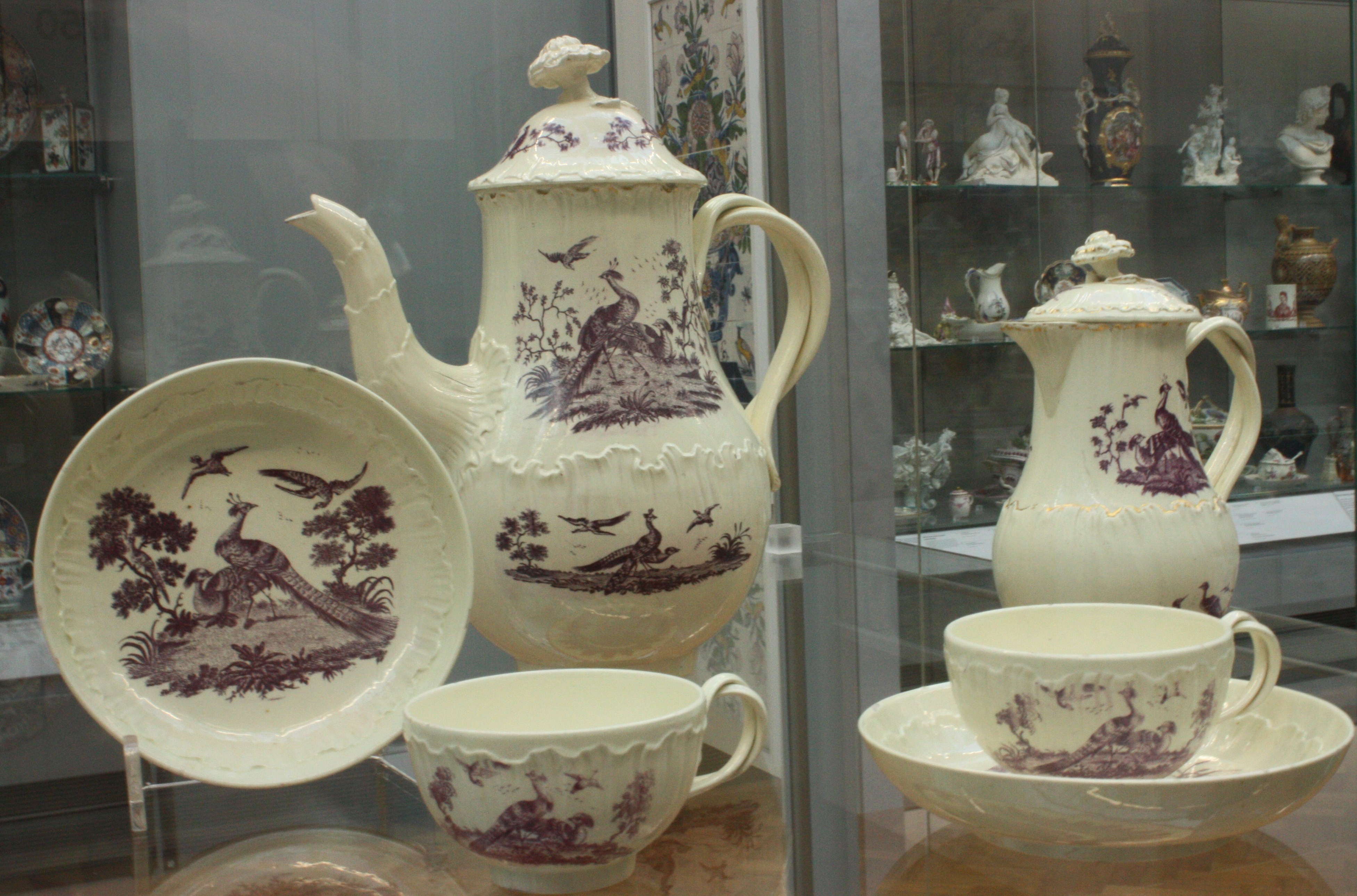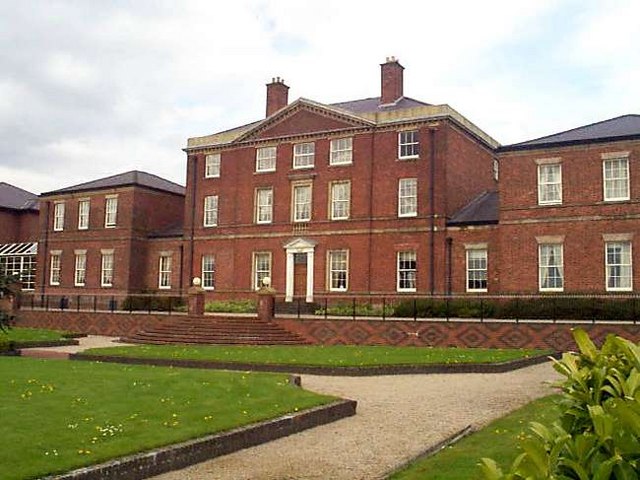|
Creamware
Creamware is a cream-coloured refined earthenware with a lead glaze over a pale body, known in France as '' faïence fine'', in the Netherlands as ''Engels porselein'', and in Italy as ''terraglia inglese''.Osborne, 140 It was created about 1750 by the potters of Staffordshire, England, who refined the materials and techniques of salt-glazed earthenware towards a finer, thinner, whiter body with a brilliant glassy lead glaze, which proved so ideal for domestic ware that it supplanted white salt-glaze wares by about 1780. It was popular until the 1840s. Variations of creamware were known as "tortoiseshell ware" or "Whieldon ware" were developed by the master potter Thomas Whieldon with coloured stains under the glaze. It served as an inexpensive substitute for the soft-paste porcelains being developed by contemporary English manufactories, initially in competition with Chinese export porcelains. It was often made in the same fashionable and refined styles as porcelain. T ... [...More Info...] [...Related Items...] OR: [Wikipedia] [Google] [Baidu] |
Donald Chisholm Towner
Donald Chisholm Towner (born Eastbourne, East Sussex, England, 1903; died London 1985) was a collector and historian of British ceramics and painter. He is noted for his championship of creamware and his ground-breaking studies of this ceramic type in particular.Rachel Conroy, “‘The most lovely of all ceramics’: the creamware sketches of Donald C Towner at Temple Newsam, Leeds,” in ''English Ceramic Circle Transactions'' Volume 31, 2020, pp. 213-227. ECC, 2021 Early life Donald Towner was born in Eastbourne in 1903, the youngest of three boys. His father William was a teacher and amateur artist who inspired his interest in nature and art. Donald's great-uncle, John Chisolm Towner, enabled through a legacy the founding of the Towner Art Gallery in Eastbourne. Donald Towner went to school as a boarder in 1915 at Southdown College, Willingdon and the attended Eastbourne Municipal School, where he first met Eric Ravilious, later gaining a scholarship to the Eastbourne Sc ... [...More Info...] [...Related Items...] OR: [Wikipedia] [Google] [Baidu] |
Thomas Whieldon
Thomas Whieldon (September 1719 in Penkhull, Stoke-on-Trent – March 1795) was a significant English potter who played a leading role in the development of Staffordshire pottery. The attribution of actual pieces to his factory has long been uncertain, and terms such as "Whieldon-type" are now often used for a variety of different types of wares. Other terms reflecting the lack of certainty are "Whieldon ware" as a type, and "Astbury-Whieldon", used for early Staffordshire figures, where the two were pioneers. He worked in earthenware and stoneware, using a variety of types of body and ceramic glazes. He is especially associated with agate ware and tortoiseshell ware; in both cases Whieldon refined the techniques used, and made the types more popular. Family Whieldon is first recorded as a potter in 1744 when he married Anne Shaw at Barlaston Church. Little is known about his early career and it is not known where he served his apprenticeship. Anne died in 1757 and in ... [...More Info...] [...Related Items...] OR: [Wikipedia] [Google] [Baidu] |
Josiah Wedgwood
Josiah Wedgwood (12 July 1730 – 3 January 1795) was an English potter, entrepreneur and abolitionist. Founding the Wedgwood company in 1759, he developed improved pottery bodies by systematic experimentation, and was the leader in the industrialisation of the manufacture of European pottery. The renewed classical enthusiasms of the late 1760s and early 1770s were of major importance to his sales promotion. His expensive goods were in much demand from the upper classes, while he used emulation effects to market cheaper sets to the rest of society. Every new invention that Wedgwood produced – green glaze, creamware, black basalt, and jasperware – was quickly copied. Having once achieved efficiency in production, he obtained efficiencies in sales and distribution. His showrooms in London gave the public the chance to see his complete range of tableware. Wedgwood's company never made porcelain during his lifetime, but specialised in fine earthenwares and stonewares that h ... [...More Info...] [...Related Items...] OR: [Wikipedia] [Google] [Baidu] |
Faïence
Faience or faïence (; ) is the general English language term for fine tin-glazed pottery. The invention of a white pottery glaze suitable for painted decoration, by the addition of an oxide of tin to the slip of a lead glaze, was a major advance in the history of pottery. The invention seems to have been made in Iran or the Middle East before the ninth century. A kiln capable of producing temperatures exceeding was required to achieve this result, the result of millennia of refined pottery-making traditions. The term is now used for a wide variety of pottery from several parts of the world, including many types of European painted wares, often produced as cheaper versions of porcelain styles. English generally uses various other terms for well-known sub-types of faience. Italian tin-glazed earthenware, at least the early forms, is called maiolica in English, Dutch wares are called Delftware, and their English equivalents English delftware, leaving "faience" as the normal t ... [...More Info...] [...Related Items...] OR: [Wikipedia] [Google] [Baidu] |
Faience
Faience or faïence (; ) is the general English language term for fine tin-glazed pottery. The invention of a white pottery glaze suitable for painted decoration, by the addition of an oxide of tin to the slip of a lead glaze, was a major advance in the history of pottery. The invention seems to have been made in Iran or the Middle East before the ninth century. A kiln capable of producing temperatures exceeding was required to achieve this result, the result of millennia of refined pottery-making traditions. The term is now used for a wide variety of pottery from several parts of the world, including many types of European painted wares, often produced as cheaper versions of porcelain styles. English generally uses various other terms for well-known sub-types of faience. Italian tin-glazed earthenware, at least the early forms, is called maiolica in English, Dutch wares are called Delftware, and their English equivalents English delftware, leaving "faience" as the normal te ... [...More Info...] [...Related Items...] OR: [Wikipedia] [Google] [Baidu] |
Leeds Pottery
Leeds Pottery, also known as Hartley Greens & Co., is a pottery manufacturer founded around 1756 in Hunslet, just south of Leeds, England. It is best known for its creamware, which is often called Leedsware; it was the "most important rival" in this highly popular ware of Wedgwood, who had invented the improved version used from the 1760s on. Many pieces include openwork, made either by piercing solid parts, or "basketwork", weaving thin strips of clay together. Several other types of ware were produced, mostly earthenware but with some stoneware. Wares The pottery produced catalogues of goods in 1783, 1785, 1786, 1794, and 1814; the pattern is somewhat indicative of the development of the business. There are other documents, and pattern books illustrating decoration, in the Leeds City Art Gallery and the Victoria & Albert Museum in London. By 1790 the company employed 150 people. Leeds wares were lighter than those of most of their competitors, which gave them an advantage ... [...More Info...] [...Related Items...] OR: [Wikipedia] [Google] [Baidu] |
Earthenware
Earthenware is glazed or unglazed nonvitreous pottery that has normally been fired below . Basic earthenware, often called terracotta, absorbs liquids such as water. However, earthenware can be made impervious to liquids by coating it with a ceramic glaze, which the great majority of modern domestic earthenware has. The main other important types of pottery are porcelain, bone china, and stoneware, all fired at high enough temperatures to vitrify. Earthenware comprises "most building bricks, nearly all European pottery up to the seventeenth century, most of the wares of Egypt, Persia and the near East; Greek, Roman and Mediterranean, and some of the Chinese; and the fine earthenware which forms the greater part of our tableware today" ("today" being 1962).Dora Billington, ''The Technique of Pottery'', London: B.T.Batsford, 1962 Pit fired earthenware dates back to as early as 29,000–25,000 BC, and for millennia, only earthenware pottery was made, with stoneware graduall ... [...More Info...] [...Related Items...] OR: [Wikipedia] [Google] [Baidu] |
Frog Service
The Frog Service or Green Frog Service is a large dinner and dessert service made by the English pottery company Wedgwood for Empress Catherine the Great of Russia, and completed in 1774. The service had fifty settings, and 944 pieces were ordered, 680 for the dinner service and 264 for the dessert. At Catherine's request the hand-painted decoration showed British scenes, copied from prints, with a total of 1,222 views. In addition each piece had a green frog within a shield, a reference to the name of the palace it was intended for. Most unusually for a formal royal service, it was made from Wedgwood's "Queen's ware", the firm's type of creamware or fine earthenware. Normally, large services for royalty and the top nobility were in porcelain, like the Meissen Swan Service, and an imperial order for a large earthenware service was a great coup, representing a landmark in Staffordshire pottery's conquest of European markets. The great majority of pieces are now in the State Her ... [...More Info...] [...Related Items...] OR: [Wikipedia] [Google] [Baidu] |
Tin-glaze
Tin-glazing is the process of giving tin-glazed pottery items a ceramic glaze that is white, glossy and opaque, which is normally applied to red or buff earthenware. Tin-glaze is plain lead glaze with a small amount of tin oxide added.Caiger-Smith, Alan, ''Tin-Glaze Pottery in Europe and the Islamic World: The Tradition of 1000 Years in Maiolica, Faience and Delftware'', London, Faber and Faber, 1973 The opacity and whiteness of tin glaze encourage its frequent decoration. Historically this has mostly been done before the single firing, when the colours blend into the glaze, but since the 17th century also using overglaze enamels, with a light second firing, allowing a wider range of colours. Majolica, maiolica, delftware and faience are among the terms used for common types of tin-glazed pottery. An alternative is lead-glazing, where the basic glaze is transparent; some types of pottery use both. However, when pieces are glazed only with lead, the glaze becomes fluid during f ... [...More Info...] [...Related Items...] OR: [Wikipedia] [Google] [Baidu] |
Devonshire
Devon ( , historically known as Devonshire , ) is a ceremonial and non-metropolitan county in South West England. The most populous settlement in Devon is the city of Plymouth, followed by Devon's county town, the city of Exeter. Devon is a coastal county with cliffs and sandy beaches. Home to the largest open space in southern England, Dartmoor (), the county is predominately rural and has a relatively low population density for an English county. The county is bordered by Somerset to the north east, Dorset to the east, and Cornwall to the west. The county is split into the non-metropolitan districts of East Devon, Mid Devon, North Devon, South Hams, Teignbridge, Torridge, West Devon, Exeter, and the unitary authority areas of Plymouth, and Torbay. Combined as a ceremonial county, Devon's area is and its population is about 1.2 million. Devon derives its name from Dumnonia (the shift from ''m'' to ''v'' is a typical Celtic consonant shift). During the Brit ... [...More Info...] [...Related Items...] OR: [Wikipedia] [Google] [Baidu] |
Flint
Flint, occasionally flintstone, is a sedimentary cryptocrystalline form of the mineral quartz, categorized as the variety of chert that occurs in chalk or marly limestone. Flint was widely used historically to make stone tools and start fires. It occurs chiefly as nodules and masses in sedimentary rocks, such as chalks and limestones.''The Flints from Portsdown Hill'' Inside the nodule, flint is usually dark grey, black, green, white or brown in colour, and often has a glassy or waxy appearance. A thin layer on the outside of the nodules is usually different in colour, typically white and rough in texture. The nodules can often be found along streams and [...More Info...] [...Related Items...] OR: [Wikipedia] [Google] [Baidu] |



.jpg)


